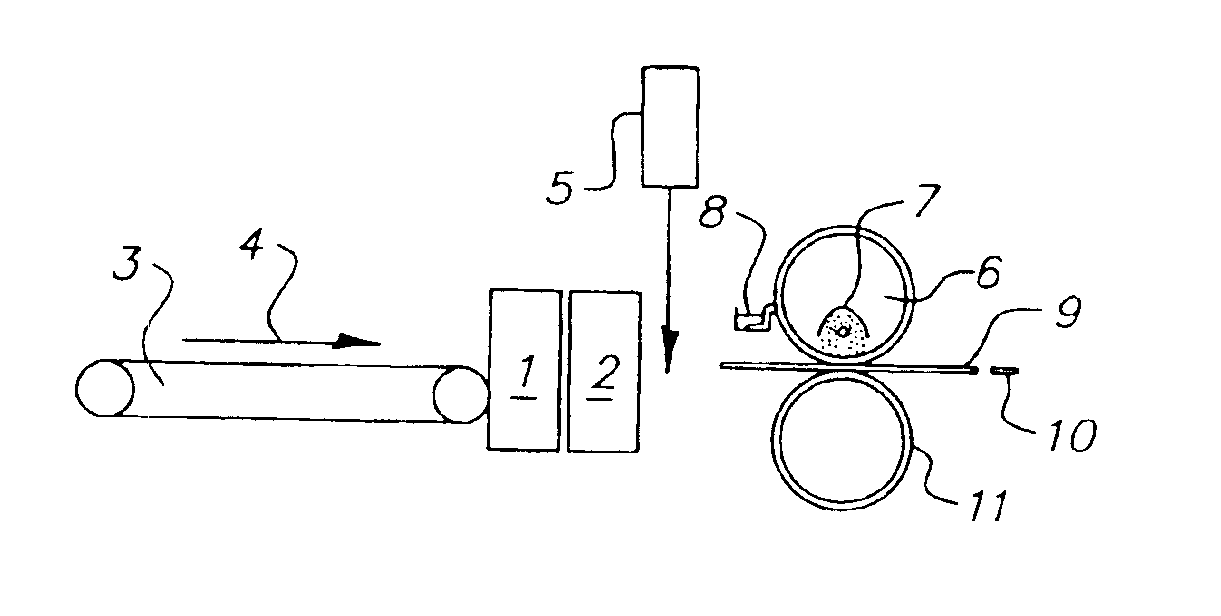Method and device for fusing toner onto a substrate
a technology of toner and substrate, which is applied in the direction of electrographic process equipment, instruments, optics, etc., can solve the problems of limited chance of positively influencing the gloss of the print image, narrow confinement of temperature change, transfer and subsequent printing could be damaged, etc., to achieve high electric field strength, increase the efficiency of the microwave system, and increase the effect of electric field strength
- Summary
- Abstract
- Description
- Claims
- Application Information
AI Technical Summary
Benefits of technology
Problems solved by technology
Method used
Image
Examples
example 1 (table 1)
[0037]
Toner / FusingPaperPaperRollerSurfacePaperFusingTem-Tem-Tem-SpeedTimeperatureperatureperatureComment 30 cm / s60 ms27° C.160° C.110° C.No MicrowaveHeating 45 cm / s40 ms44° C.160° C.110° C.2 × 1500 kW 60 cm / s30 ms54° C.160° C.110° C.2 × 2000 kW 90 cm / s20 ms65° C.160° C.110° C.4 × 2000 kW120 cm / s15 ms72° C.160° C.110° C.4 × 3200 kW
example 2 (table 2)
[0038]
Toner / FusingPaperPaperRollerSurfacePaperFusingTem-Tem-Tem-SpeedTimeperatureperatureperatureComment 30 cm / s60 ms27° C.160° C.112° C.No MicrowaveHeating 45 cm / s40 ms40° C.160° C.112° C.2 × 1500 kW 60 cm / s30 ms48° C.160° C.112° C.2 × 2000 kW 90 cm / s20 ms59° C.160° C.110° C.4 × 2000 kW120 cm / s15 ms67° C.160° C.110° C.4 × 3200 kW
[0039]The tables show the paper speed, the fusing time per nip of the fusing roller of 18 mm, and the paper temperature at the exit of the microwave heating device, which is required in order to reach a paper-to-toner surface or interface temperature of approximately 110° C., which is necessary to fuse conventional toner with a fusing roller surface temperature of 160° C. The data specified are experimental and calculated from models.
[0040]FIG. 3 shows a second embodiment of a combination of a microwave heating and a fusing roller according to the invention. The same components are designated with the same reference numbers as in FIG. 1. The line pyrometer ...
PUM
 Login to View More
Login to View More Abstract
Description
Claims
Application Information
 Login to View More
Login to View More - R&D
- Intellectual Property
- Life Sciences
- Materials
- Tech Scout
- Unparalleled Data Quality
- Higher Quality Content
- 60% Fewer Hallucinations
Browse by: Latest US Patents, China's latest patents, Technical Efficacy Thesaurus, Application Domain, Technology Topic, Popular Technical Reports.
© 2025 PatSnap. All rights reserved.Legal|Privacy policy|Modern Slavery Act Transparency Statement|Sitemap|About US| Contact US: help@patsnap.com


